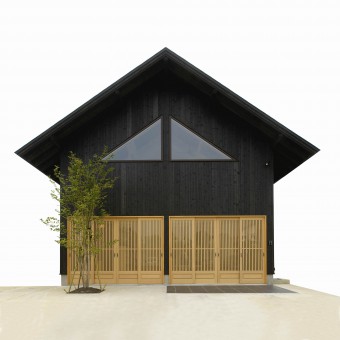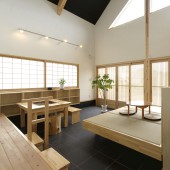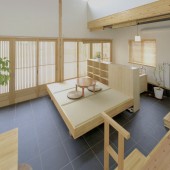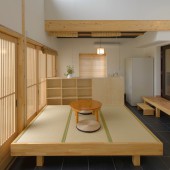
| THE AWARD |
| CATEGORIES |
| REGISTRATION |
| SUBMIT YOUR WORK |
| ENTRY INSTRUCTIONS |
| TERMS & CONDITIONS |
| PUBLICATIONS |
| DATES & FEES |
| METHODOLOGY |
| CONTACT |
| WINNERS |
| PRESS ROOM |
| GET INVOLVED |
| DESIGN PRIZE |
| DESIGN STORE |
| THE AWARD | JURY | CATEGORIES | REGISTRATION | PRESS | WINNERS | PUBLICATIONS | ENTRY INSTRUCTIONS |
I House Residence by YOSHIHIRO MATSUURA |
Home > Winners > Design #50066 >Interview |
 |
|
FS: What is the main principle, idea and inspiration behind your design?
YM: Our area is in the northernmost part of Japanese mainland, and is also in a heavy snowfall area. This house was built in the affected area of the Great East Japan Earthquake, for the revival from the disaster.I needed to build the house without depending on the nuclear power plant as much as possible.I considered building the house which gave hope even a little for the victims of the frozen Tohoku district.
FS: What has been your main focus in designing this work? Especially what did you want to achieve?
YM: The design of this house is considered to coexist with nature.Especially, I needed to design the house that has warmth conducted by natural sunlight and human temperature, without depending on the heating equipment as much as possible.
FS: What are your future plans for this award winning design?
YM: Our plans are providing self-sustaining houses which are generated by the natural energy, without depending on the nuclear power plant as much as possible.
FS: How long did it take you to design this particular concept?
YM: It took three years to complete this design since I stated to develop this idea after the Great East Earthquake.
FS: Why did you design this particular concept? Was this design commissioned or did you decide to pursuit an inspiration?
YM: Because I wanted to raise the spirits of the people in Tohoku district, who had difficult experiences after the earthquake.
FS: Is your design being produced or used by another company, or do you plan to sell or lease the production rights or do you intent to produce your work yourself?
YM: This design is produced by my company. The production right belongs to us.
FS: What made you design this particular type of work?
YM: A willingness to raise the spirit of people in the stricken Tohoku district, even just a little bit, is motivation of this work.
FS: Where there any other designs and/or designers that helped the influence the design of your work?
YM: The works I designed by myself in the past always affects me.
FS: Who is the target customer for his design?
YM: Our targets are all entire local people, because I value my hometown.
FS: What sets this design apart from other similar or resembling concepts?
YM: The residents can make good use of the dirt floor space in summer, have a comfortable time in the No-heating dwelling part in winter. It means that they can spend a very nice time all year around while saving energy.
FS: How did you come up with the name for this design? What does it mean?
YM: The meaning of the name “i-HOUSE” comes from “an intelligent house”. This name is my intention of support, hoping that people can think out a living method with intelligence to severe weather in Tohoku, and can coexist with nature.
FS: Which design tools did you use when you were working on this project?
YM: The best designing tool for me is to take a walk in nature. By strolling, I can talk with nature, just relax, and nature often gives me an idea for building architecture.
FS: What is the most unique aspect of your design?
YM: The most unique aspect of this house is that the dirt floor, where guests can walk in freely, occupies the much space of the house. I tried to design the house where local people feel free to visit.
FS: Who did you collaborate with for this design? Did you work with people with technical / specialized skills?
YM: It was not technical support, but the best supporters of this housing design were earthquake victims. I had been the affected area so many times, walked around there and talked with them. Many of them told their demands to me. Frank opinions from victims are reflected to this house.
FS: What is the role of technology in this particular design?
YM: The best technology used in this house is highly advanced energy conservation technology. This idea comes from my experience, having watched the tragic state caused by the Fukushima nuclear power plant. I will contribute my humble efforts to build houses needing no nuclear power as much as possible.
FS: Is your design influenced by data or analytical research in any way? What kind of research did you conduct for making this design?
YM: Q-value measurement is all for this house. For planning a house needing home heater very little, I thought it is ideal to design the house those Q-value is below 0.7. Q-value of this house is 0.49, highly advanced insulating technology.
FS: What are some of the challenges you faced during the design/realization of your concept?
YM: This is highly advanced insulating house, but it had to be an affordable one. Since the beginning of the plan, this house was for victims of the earthquake. It had been within the budget of ordinary people. I had spent almost three years to work out the idea to realize this low cost house.
FS: How did you decide to submit your design to an international design competition?
YM: Special invitation E-mail from A’ design Award made me to decide to submit my design.
FS: What did you learn or how did you improve yourself during the designing of this work?
YM: I learned myself that, all designs exist for people, while planning this house. Especially, I persuade myself that, listening intently to someone’s opinion is very important. I gave attention to improve myself.
FS: Any other things you would like to cover that have not been covered in these questions?
YM: The concept of this house is to preserve and value the Japanese tradition, and consider it to adopt the state of the art technologies. Taking back the bright future for children in East Japan is the mission of us, the designers. The nostalgic Japanese identity and the bright future of children, these two things are contrastive in a sense, but both are united to the concept of this “i-HOUSE”.
FS: Thank you for providing us with this opportunity to interview you.
A' Design Award and Competitions grants rights to press members and bloggers to use parts of this interview. This interview is provided as it is; DesignPRWire and A' Design Award and Competitions cannot be held responsible for the answers given by participating designers.
| SOCIAL |
| + Add to Likes / Favorites | Send to My Email | Comment | View Press-Release |




